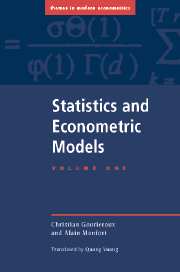Book contents
- Frontmatter
- Contents
- Preface
- 1 Models
- 2 Statistical Problems and Decision Theory
- 3 Statistical Information: Classical Approach
- 4 Bayesian Interpretations of Sufficiency, Ancillarity, and Identification
- 5 Elements of Estimation Theory
- 6 Unbiased Estimation
- 7 Maximum Likelihood Estimation
- 8 M-Estimation
- 9 Methods of Moments and Their Generalizations
- 10 Estimation Under Equality Constraints
- 11 Prediction
- 12 Bayesian Estimation
- 13 Numerical Procedures
- Appendix tables
- Index
3 - Statistical Information: Classical Approach
Published online by Cambridge University Press: 04 August 2010
- Frontmatter
- Contents
- Preface
- 1 Models
- 2 Statistical Problems and Decision Theory
- 3 Statistical Information: Classical Approach
- 4 Bayesian Interpretations of Sufficiency, Ancillarity, and Identification
- 5 Elements of Estimation Theory
- 6 Unbiased Estimation
- 7 Maximum Likelihood Estimation
- 8 M-Estimation
- 9 Methods of Moments and Their Generalizations
- 10 Estimation Under Equality Constraints
- 11 Prediction
- 12 Bayesian Estimation
- 13 Numerical Procedures
- Appendix tables
- Index
Summary
As discussed in the previous chapter, on the one hand, problems of estimation and testing are defined with respect to a function of the parameters. On the other hand, methods that answer these problems are based on functions of the observations. In the present chapter, we shall focus on the “information” on a given function of the parameters that is contained in a function of the observations, i.e., in a statistic. We shall study successively the following four issues:
a) Characterize the statistics that contain all the available information regarding the parameter function of interest. These are called sufficient statistics.
b) Characterize the statistics that contain no information regarding the parameter function of interest. These are called ancillary statistics.
c) Measure the loss of information associated with a given statistic that is neither sufficient nor ancillary.
d) Characterize the functions or the values of the parameters for which it is impossible to be completely informed. This is the so-called identification problem.
In this chapter, we shall study these issues within a classical framework, i.e., within a decision theoretical framework without a prior distribution on the parameters. Similar results are established in Chapter 4 within the Bayesian and empirical Bayesian frameworks.
Sufficiency
Definition
Suppose that an entrepreneur receives an important shipment of industrial parts. The shipment contains an unknown proportion θ of defective parts. Because a systematic quality control is too expensive, the entrepreneur only checks a sample of n parts. It is assumed that each part is randomly drawn with equal probability and replacement.
- Type
- Chapter
- Information
- Statistics and Econometric Models , pp. 67 - 100Publisher: Cambridge University PressPrint publication year: 1995



